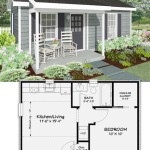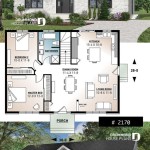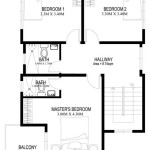One Bedroom House Layout Plans: Maximizing Space and Functionality
One bedroom house layout plans represent a significant design challenge: to create a comfortable and functional living space within a limited footprint. These plans are popular among single individuals, couples, or those seeking compact and efficient living arrangements. A well-designed one bedroom house can provide all the necessities of a larger home, albeit in a more streamlined and thoughtfully organized manner. The key to successful one bedroom house layouts lies in optimizing every square foot, prioritizing multifunctional spaces, and creating a sense of openness and flow.
This article will explore various aspects of one bedroom house layout plans, including considerations for space optimization, functional zones, storage solutions, and design aesthetics. The aim is to provide a comprehensive overview of the essential elements involved in creating a comfortable and efficient one bedroom living space.
Prioritizing Functionality and Flow in One Bedroom Layouts
The single most important aspect of a successful one bedroom house layout is functionality. Every area should serve a purpose, and the transitions between zones should be seamless. The layout should facilitate the daily routines of the occupant(s) without feeling cramped or restrictive. This often requires creative solutions and a willingness to think outside the box when it comes to traditional room designations.
Open-concept living is a prevalent trend in one bedroom designs. This involves combining the living room, dining area, and kitchen into a single, unified space. This approach can create a larger and more airy feel, especially in smaller homes. However, careful consideration must be given to defining each zone within the open space. This can be achieved through the use of furniture placement, area rugs, changes in flooring, or subtle architectural details like partial walls or columns.
Traffic flow is another critical factor. The layout should allow for easy movement between rooms and activity areas. Avoid creating bottlenecks or narrow passageways that can make the space feel claustrophobic. Furniture should be arranged to facilitate movement, and doors should swing in a direction that minimizes obstruction.
The bedroom itself should be a sanctuary, a place for rest and relaxation. It should be separated from the main living area to provide a sense of privacy and quiet. The bedroom should ideally accommodate a bed, a dresser, and perhaps a small seating area. A walk-in closet, if space allows, can be a significant asset.
The bathroom is another essential space that requires careful planning. A well-designed bathroom should be functional, easy to clean, and aesthetically pleasing. In smaller one bedroom houses, the bathroom may need to be compact, but it should still provide all the necessary amenities, such as a toilet, sink, and shower or bathtub.
The entrance or foyer, even in a small one bedroom house, should be given some attention. This area serves as a transition zone between the outside world and the interior living space. It should be welcoming and functional, providing a place to store shoes, coats, and other outerwear. A small entrance console table or a wall-mounted coat rack can be effective additions to this area.
Optimizing Space with Smart Storage Solutions
Storage is often a major concern in one bedroom houses. With limited space, it is crucial to maximize every available nook and cranny for storage. This requires a strategic approach to storage design, incorporating both built-in and freestanding solutions.
Built-in storage is generally the most space-efficient option. This can include shelving units, cabinets, and drawers that are integrated into the walls or other architectural features. Built-in storage can be customized to fit specific needs and can be designed to blend seamlessly with the overall aesthetic of the house.
Under-bed storage is a popular and practical solution for storing clothing, linens, and other items. Beds with built-in drawers or platforms that lift up to reveal storage compartments are readily available. This is an excellent way to utilize otherwise unused space.
Vertical storage is another effective strategy for maximizing space. Tall bookshelves, wall-mounted shelves, and hanging organizers can help to utilize the vertical space in a room, freeing up floor space. This is particularly useful in the living room and bedroom.
Multifunctional furniture can also contribute to space optimization. Sofas that convert into beds, coffee tables with storage compartments, and ottomans that can be used as seating or storage are all examples of furniture that serve multiple purposes. These types of furniture are particularly well-suited for one bedroom houses.
Consider incorporating storage into unexpected places. For example, the space above the refrigerator can be used for storing infrequently used items. The space under the stairs (if applicable) can be transformed into a storage closet. Even the space behind a door can be utilized with the addition of a hanging organizer.
In the kitchen, maximize cabinet space by using organizers and dividers. Pull-out shelves and drawers can make it easier to access items stored in the back of cabinets. Hanging pot racks can free up cabinet space and add a decorative touch to the kitchen.
Designing for Aesthetic Appeal and Personalization
While functionality and space optimization are paramount, aesthetic appeal should not be overlooked. A one bedroom house should be a comfortable and inviting space that reflects the personality of the occupant(s). This can be achieved through careful selection of colors, materials, furniture, and décor.
A cohesive color scheme can create a sense of harmony and flow throughout the house. Neutral colors, such as white, gray, and beige, are often used as a base, as they create a sense of spaciousness and can be easily complemented with accent colors. Accent colors can be used to add pops of color and personality to the space.
Natural light is a valuable asset in any home, but it is especially important in smaller spaces. Maximize natural light by using sheer curtains or blinds that allow light to filter through. Mirrors can also be used to reflect light and create a sense of depth.
Artwork and personal mementos can add character and personality to a one bedroom house. Choose pieces that reflect your interests and style. Consider creating a gallery wall or showcasing a few statement pieces.
Textiles, such as rugs, curtains, and throw pillows, can add warmth and texture to a space. These elements can also be used to define different zones within an open-concept layout. For example, an area rug can be used to delineate the living room area from the dining area.
Greenery can bring life and freshness to a one bedroom house. Plants can improve air quality and add a touch of nature to the indoor environment. Choose plants that are well-suited for indoor conditions and that complement the overall aesthetic of the house.
Finally, remember that design is a personal process. Experiment with different ideas and find what works best for you. Don't be afraid to break the rules and create a space that is truly unique and reflective of your individual style. Consider the overall feeling you want to create in the space and make choices that contribute to that feeling.
Careful attention to detail can elevate a one bedroom house from a simple living space to a stylish and comfortable home. By prioritizing functionality, optimizing space, and incorporating personal touches, it is possible to create a one bedroom house that is both practical and aesthetically pleasing.

Ranch Style House Plan 1 Beds Baths 896 Sq Ft 771 One Bedroom Plans Small Floor

One Bedroom House Plans For Starter Homes Ck

1 Bedroom House Plan Examples

1 Bedroom Apartment House Plans

Mediterranean Style House Plan 1 Beds Baths 768 Sq Ft 111 One Bedroom Plans

1 Bedroom House Plan Examples

One Bedroom House Plans For Starter Homes Ck

International House 1 Bedroom Floor Plan Top View One Plans

1 Bedroom Apartment House Plans

One Bedroom House Plans Peggy
Related Posts








